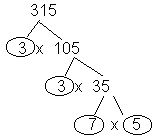Year 2 Lesson Plan 11 - Prime Factors, Greatest
Common Factors, Least Common Multiples
- (5 min) Mental Math
- Find 80% of 800; subtract 40; now divide by 4. [150]
- Find 7% of $100; double your answer; now subtract $5.95. [$8.05]
- Is 51 divisible by 3? [yes]
- Find 75% of 1000; add 250; now divide by 4 [250]
- Start with 18; multiply by 1/6; now multiply by 15. [45]
- (5 min) Review of selected problems from last lesson (no more than 3
problems)
- Pass out the 2-sided handout and use it in the following discussions:
- (20 min) A factor of a number is a divisor of that number
that leaves no remainder. A prime number is an integer,
greater than 1, whose only positive factors are 1 and itself. Write
the numbers from 1 to 30 and let the class yell out which ones are
prime as you write. [2,3,5,7,11,13,17,19,23,29] The prime factors
or prime factorization break down the factors of a number into
prime numbers. You do it with a tree, dividing each branch as you go down
until only prime numbers are on the bottom. Put a circle around the
primes so you know when you are finished. It doesn't matter how you go
about dividing a number, the prime factors always end up the same.

The prime factorization of 315 is 3 x 3 x 5 x 7 or 32 x 5 x 7.
Do another: The prime factors of 60 are 3 x 5 x 2 x 2
- The Greatest common factor (GCF) is the largest number that is
a factor of two other numbers.
You can get the GCF of large numbers by calculating all the factors of
both numbers and finding the largest one that is the same. What is the
GCF of 44 and 66?
The factors of 44 are: 1, 2, 4, 11, 22, 44
The factors of 66 are: 1, 2, 3, 11, 22, 33, 66
The largest factor of both numbers (GCF) is 22
- The Least Common Multiple (LCM) is the smallest number that
two numbers can be divided into. A multiple is bigger than either number.
What is the LCM of 12 and 16? [48]
You can get the LCM of two numbers by calculating multiples of one and
checking to see if the other fits:
12 x 2 = 24 Does 16 fit? [no]
12 x 3 = 36 Does 16 fit? [no]
12 x 4 = 48 Does 16 fit? [yes]
LCM's are used for common denominators.
- (Remainder of class) In-class exercise
- Hand out homework as students successfully complete the in-class exercise.
|